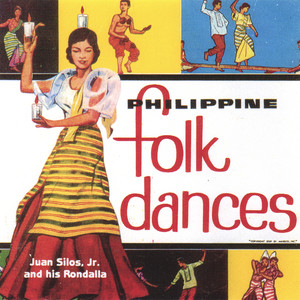
Philippine Folk Dance Vol.1
- 流派:World Music 世界音乐
- 语种:英语
- 发行时间:1958-01-01
- 类型:录音室专辑
- 歌曲
- 时长
简介
This CD is a first of a series of Philippine Folk dance recordings, as arranged by some of the best known Filipino artists/arrangers and composers performed by the Rondalla under the baton of Juan Silos Jr. We sincerely hope that these pieces will contribute our share in arousing the Filipino’s pride in their rich and distinctive musical heritage, while providing others with another rare opportunity to gain a fuller perspective of the true Philippine soul and culture. Villar Records feel the necessity for wider exploitation of tradition-laden Filipino folk songs. For social gatherings, in school, theaters and activities wherever and whenever a cultural portrait of the Filipino is desired, colorful Philippine Folk dances can always provide enchanting hours of listening pleasure. FOLK DANCE DESCRIPTIONS: 1). POLKABAL- A lively dance of rich historical origin loved by young people. It acquired its name from two well known dance steps: polka and valse (waltz). 2). MAZURKA BOHOLANA: Popular in Bohol and other provinces, the mazurka is one of the traditional ballroom dances introduced in the Philippines by early European settlersand by Filipinos who came from abroad. 3). HABANERA BOTOLENA : A colorful couple dance from Botolan, Zambales performed during weddings, baptisms and village fiestas. 4). JOTA MONCADENA: “La Jota “ dances were favorites during social gatherings in Spanish officialdom. Old people from the town of Moncada, in Tarlac province adapted the Jota in “Jota Monacadena”, resulting in a combination of Spanish and Ilocano dance steps. 5). MAGLALATIK: A ceremonial dance depicting the battle of the Muslims and the Christians over the coconut residue “latik”. 6). ITIK-ITIK: Folk-improvised movements and steps in imitation of ducks walking in short choppy steps and splashing water over their bodies while calling for their mates. It derives its name from the “itik” which means duck. 7).SAKUTING: A ritual dance from Abra province, in celebration of victory especially around Christmas time . 8). PANDANGGO SA ILAW: One of the most difficult of folk dances, this is performed with props(oil lamps) and demands considerable skill and grace from the dancers who must balance three lighted oil lamps(tinghoy) – one on the head and one on the back of each hand. 9). PAGTATANIM (Planting) – Rice the staple crop of the Philippines, is glorified in 10). BAYUHAN (Pounding) these occupational dances depicting various stages in 11). PAGTATAHIP (Winnowing) rice growing, planting, winnowing,pounding etc. 12). BAKYA DANCE : With rice in their bins,work for one season is over and the village folk make merry. The “bakya”, rustic wooden clogs, are featured in this dance. 13). PANDANGGO SA SAMBALILO: A very interesting courtship dance from Camiling, Tarlac province involving a hat. The boy tries to impress the girl by picking up the hat from the floor, by his head, unaided by hands. 14). KURATSA: This is a very popular dance in the Visayan Islands. The dancers make and select their own dance steps so that everything depends on the ability, inclination and mood of the dancers at the time of performance. 15). TINIKLING: In Leyte where this dance originated, the “Tinikling” used to be performed between two long bamboos. It is a dance imitating the movements of “tikling” birds as they play and chase each other. Hence it is named after the bird “tikling”.

